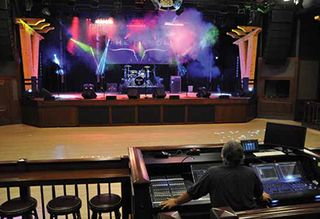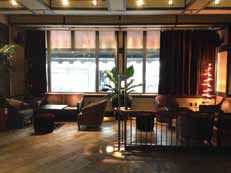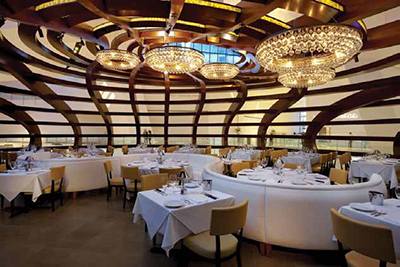Mastro’s Ocean Club at City Center in Las Vegas, NV has a multi-zone audio system that includes a selection of JBL Control Contractor Series loudspeakers, Crown Audio amplifiers, dbx ZonePRO digital zone processors, and AKG microphones and accessories. Automated Environments, electronic systems integrators based in Mesa, AZ, designed and installed the system.Clubbing: It’s not what it used to be.
Now, while you’re shaking it to a hot salsa beat in one room of a venue, your friends can be cooling down with jazz in another. Chalk it up to the wonders of multizone audio systems designed to be handily operated by end-users.
Given the plethora of openarchitecture DSP products and new design software offerings, end-users expect you to deliver audio systems that can be easily controlled, said Steve Seable, DSP product manager for Yamaha Commercial Audio. “The movement I see in the market is toward products that work well and conveniently together. In restaurants, clubs, and bars with several audio zones, customers want power, the best sound quality they can afford, and good control over paging and background music. So the trend is to make everything in the system operate with the ease of a smart phone.”
Yamaha’s DME64N, DME24N, and DME Satellite Series open architecture processors are typically targeted for larger projects with complex AV systems such as stadiums. But its new MTX Series matrix processor is designed primarily for multi-zone commercial installations and is preconfigured, so there is less time required for upfront design, he added. “These have a fixed architecture with several available control features including wall controllers and iPhone/iPad apps for wireless controls, and we’re looking into the possibility of adding an Android app. A restaurant hostess/bartender, for example, would be the ideal user for this iPod type of control.
Network integration is important in DSP, Seable noted. “In hotel installations where rooms are spread out, just using analog becomes expensive given the cost of copper and distance limitations. Going digital ties the audio into the infrastructure and takes advantage of a resource already in place. We’re creating DSP with enough extra processing built in to accommodate new functions as market demands change, without having to change out the hardware.”

The Smithsonian Air & Space Museum in Virginia is outfitted with Peavey MediaMatrix and Crest Audio.Simply put, open architecture DSP products are the most flexible way to achieve the visions set by the designers of a variety of installations, said Kevin Ivey, general manager of commercial audio at Peavey Electronics. “They scale effectively and allow you to go from eight to thousands of zones. You also can extend control and integrate third-party control, giving the designer more options to integrate different systems under one control architecture, simplifying the system for the end-user.”
This can make the system nearly automatic, he explained. “For example, if the project features a multi-use ballroom or conference center, reconfiguration is particularly important for gaining the greatest use of the space. By sensing the configuration of the room, such as by contact closures on air walls, the DSP system can be programmed to move inputs and outputs, adjust levels, reset EQs, or manage any other audio, video, or control aspect of the space.”
But do these openarchitecture DSP products and new design software offerings actually improve projects and profits?
“My favorite answer is that ‘it depends,’” said Steve Macatee, director of product development and training for Rane Corporation. “But open architecture products and new software approaches improve projects by offering design and implementation flexibility such as when the system needs change during the installation process. Open architecture can handle almost any change imaginable, and quickly.”
The software DSP blocks are also now providing a much higher level of integration, he added. “So rather than providing only basic building blocks, and relying on designers to build complex audio and control behaviors from simple blocks, now entire groups of blocks inherently work together providing an application or system level solution that lacks simple bricks altogether. The underlying foundation of the blocks and their inherent functionality require no behavior building or fancy programming at all. This translates to much less time programming, faster job completion, and time to do more jobs.”
Rane’s HAL architecture easily guides even novice users through what was once complex, and is more than “just another DSP dragand- drop system,” Macatee said. “HAL does not require matrix mixing or presets for room combining and paging, and no virtual wiring is required to distribute pages and background music to multiple zones. The HAL Multiprocessor and Halogen software checks the status, location, Cat-5 wiring integrity, and ensures that audio is flowing in all peripheral devices, so you know your system is properly connected and ready to go.
HAL’s “Get on the Plane” live device display, complete with a host status green go-ahead indicator, informs the operator that all hardware devices in the original Halogen design file are physically present in the building, connected in the proper location, and control communications and all audio I/O are already working, as well as indicating the status of other functions.
At Its Core
The core of any flexible and extensible multi-zone system should support three critical aspects of the system: signal distribution, signal processing, and control. “Obviously, signal distribution to multiple zones is the main requirement, but how this is done, and the flexibility of methods to do this, is essential to the product’s success,” Ivey said.
Peavey’s MediaMatrix provides a number of ways that distribution can be handled, he said, “including extension of a few to hundreds of signals via networking (we support CobraNet and Dante audio transport protocols) to either a remote breakout I/O box (which we call CABs, or Configurable Audio Bridges) or directly to a remote power amplifier. We support provision of signal and control/monitoring of the Crest Audio multi-channel amplifiers, and those amplifiers, in turn, support low-impedance or 70- or 100-volt constant voltage systems. Most recently, we introduced the nWall 2.0, 1.1, and 0.2, two-channel CobraNet input/output panels that mount in a standard dual-gang NEMA box.”
Signal processing through MediaMatrix’s NWare software equips the consultant or designer with all of the tools they need to construct multi-zone audio and control systems, Ivey said. “This software allows the system to be designed, and the individual zones laid out, via networking, processing, and amplification. Obviously, different zones may require different processing since acoustics are different in each space. NWare is unique in that specific processing can be applied in each zone, and where required, active and automated processing can be applied to manage the ambient levels, equalization or muting of signals to specific zones.

The Ranch Restaurant and Saloon, established by Extron founder Andrew Edwards in Anaheim, CA has a networking system that includes two Yamaha M7CL digital audio consoles, using the M7CL control surface at front of house connected to a Yamaha NAI network interface, AD8HR mic pre amp, and EtherSound cards, all running off a Yamaha DME64 digital mixing engine.Peavey’s new Kiosk2Go feature, which will be included in the next release of NWare programming software, is the free software package for creating and programming audio and control systems with MediaMatrix. “Kiosk2Go is an application which will allow designers to extend their kiosk control interfaces, which they’ve created in NWare, out to any mobile device via the web browser component and HTML 5. So any control interface that a designer can create in NWare can now be used wirelessly with any Android, iOS, Blackberry, Windows, or Linux mobile device,” he said.
High Standards
MNEC, NFPA, and EN54 regulations and certifications can set the bar pretty high in terms of this implementation of audio and control systems. “Life safety and signaling is always foremost in the design of systems for public spaces,” Ivey said. “Digital audio systems like MediaMatrix are broad and flexible enough to be applied and used in manners that support the requirements of the standards. Intelligibility standards can be easily managed with distributed audio and DSP.”
Interfaces to fire alarms and other annunciation systems are satisfied with multiple options for interconnection and properly reading the status of the signal device, he added. “The application of logic circuits within NWare gives another powerful level of ‘intelligence’ to the system to determine where signals are being generated, and the ability to ‘route around’ problems. The ability to monitor and control remote power amplifiers, power distribution devices, and network switches also enables the MediaMatrix systems to keep tabs on life-safety systems to ensure that they are operational, and to access redundant systems in the event of a problem.”
MediaMatrix also supports “N+1” redundancy in its systems, meaning a one-for-one backup is not needed for systems with multiple NION processors or power amps; one redundant processor or amplifier channel can be pressed into service to take the role of a system component that has failed or has been taken out of operation by an event.
Karen Mitchell is a freelance writer living in Boulder, CO.
All in Good Fun
Multi-zone audio installation often comes with inherent rewards because of the types of associated projects and the satisfaction of introducing fresh technologies to clients.
It’s fun by its very nature, Peavey’s Kevin Ivey said. “Installations may include theme park attractions, nightclubs, casinos, bars, and restaurants; all places where people gather for fun. In selling into these installations, the fun comes in explaining what is possible to the client, and watching their imaginations go to work. I always challenge our sales force to capture the imagination of the designer, integrator, or client with the capabilities of our products, and very often we are able to do some really cool things.”
The excitement is further enhanced by a technology generation in which end-users like to show off their latest apps or want to do something in a new way. “It’s the same with DSP and audio,” Yamaha’s Steve Seable said. “Now, I can walk around anywhere in a facility and make changes happen. We get to be creative and to come up with unique ways in which the technology can be used.”
Multi-zone products provide music to enhance the experience of both business and social life, Rane’s Steve Macatee noted. “Music brings joy and fun. I’m a big music fan and spreading joy is something this world could use much more of. And it’s great fun to train installers about our HAL System since it approaches the problem in a completely unique and amazing way.”
Smartphones and tablets have brought a new level of control to even the most basic of customers, Crown’s Dan Saenz said. “Crown has designed iOS software, powered by Crown, to control networked amplifiers with iPads and iPhones. This adds a level of control for any level of user. This can be customized for simple to very complex systems. This is the proverbial icing on the cake. By delivering the latest in technology in amplification and processing, basic control over iOS devices helps tie systems together.”
Along with the fun and open aspects of multi-zone technology, manufacturers bear the challenges of ensuring that everything is still in accordance with security needs, Seable added. “When everything was analog there were whole racks of relays to control audio. Now, with software, a single rack space for DSP can provide all the needed functions. It’s all part of raised expectations from consumers due to the advent of iPads, Androids, and smart technology. We expect our whole lives to work like that.”
—K.M.
License to Listen
In smaller venues, clients often want to create background sound with iPods or online music streaming services, but what about licensing/legal challenges?
As the pro audio world becomes more and more driven by the consumer world, the need for integration of consumer-level products will grow, observed Dan Saenz, business segment manager of install sound at Crown International. “In smaller installations, end-users expect to integrate their personal sources and don’t realize the legal challenges that they face. With consumer-level gear, licensing is only covered for personal use, not for public use. This is why business services are considerably more expensive; the licensing covers public use.”
“Although there is little enforcement or even awareness of the use of personal music, satellite radio services, or online streaming for BGM, licensed content services are the safest way to go with regard to legality and the formal licensing of the content,” advised Peavey’s Kevin Ivey. “Some would argue that use of the content as BGM does not create a problem, as patrons are not being charged to hear the content, and that it is not central to the entertainment offered. But it is intellectual property created by an artist, and it deserves compensation as such.”
As for the ability of the audio distribution system itself to police such licensing, this is not something the industry has had to address, he continued. “It would be easy enough to have some sort of watermark in the content stream that identified it as licensed and legal, or the content could be encrypted and require a key for playback, and the systems could read those conditions and either play or mute the content.”
There are several ways to ensure that such music is licensed properly. ASCAP collects license fees from satellite radio services, for example, so it can be argued that those are covered, Ivey concluded. “They have also collected from BGM service companies, and those who use BGM on a large scale, such as airlines, for a very long time. Some colleges and universities pay ASCAP licensing, as well as concert presenters/promoters and orchestras. Individual restaurants, bars, hotels, and the like can also license content from ASCAP to keep things legal.”
—K.M.
A Grand Upgrade

Outfitted with a selection of microphone and line I/O and DataPort control and monitoring cards, the Q-Sys Core 250i processor enabled Canal Sound
& Light to optimize the system in each zone with custom EQ and other processing.The recent installation of a QSC Q-Sys Core 250i processing and management system has significantly improved sound quality and user control to the bar, restaurant, lounge, and lobby areas of the boutique Tribeca Grand Hotel. Systems integrator Canal Sound and Light, in consultation with Danny Taylor, a freelance audio contractor and nightclub designer, installed the Q-Sys system along with more than two dozen QSC AcousticDesign surface- and ceiling-mount loudspeakers powered by QSC CX Series amplifiers.
Located in a fashionable lower Manhattan residential neighborhood, the Tribeca Grand has been a major Manhattan nightlife attraction for more than a decade, but its audio system was beginning to show its age, according to Jeffrey Kwan, vice president at Canal Sound and Light: “Since the hotel is expanding the number of special events that they are booking, everything just needed to be improved.”
The hotel’s triangular eight-story atrium houses the Church Lounge, a cozy dining area and cocktail bar featuring regular DJ nights that has become a celebrity hotspot. “The entire atrium and lobby were re-done,” says Kwan, “and we divided everything—the dining room, bar, atrium, lobby and hallway areas—into seven zones.”
In addition to the Core 250i, Canal Sound & Light installed an assortment of QSC AcousticDesign loudspeakers including: ten AD-S282H high-output, dual 8-inch, two-way, surface-mount speakers; eight AD-S82H high-output, 8-inch, two-way, surface-mount speakers; five AD-S28TW surface-mount subwoofers (in the atrium); four AD-Ci52T compact, two-way, sealed enclosure ceiling speakers; and a single QSC KW181 18-inch subwoofer. One CX302, five CX902 and four CX1102 two-channel amplifiers drive the installed loudspeakers.
Outfitted with a selection of microphone and line I/O and DataPort control and monitoring cards, the Q-Sys Core 250i processor enabled Canal Sound & Light to optimize the system in each zone with custom EQ and other processing. “The DSP capabilities of Q-Sys are amazing. Once you dig into it, you can do so much, and have everything so organized,” said Kwan, who looks forward to using the system’s full potential in the future on more complex projects: “The system is capable of so much more, but it did what we needed to do on this project.”
The Q-Sys system also enables Canal Sound & Light to provide the Tribeca Grand’s managers with networked touch screens as well as wireless, remote level control in each zone. “One of the best things about the Q-Sys Core 250i is that it operates over standard-layer 3 Gigabit Ethernet,” said Kwan, whose crew installed the QSC TSC-3 3.5-inch touch screens in the hotel’s bar, lounge, and studio buffet/ conference room areas.
Kwan also designed a custom app using Q-Sys Designer software that enables any hotel manager to walk into a zone and adjust the audio level with a swipe of a finger on a Q-Sys network-connected iPhone.










